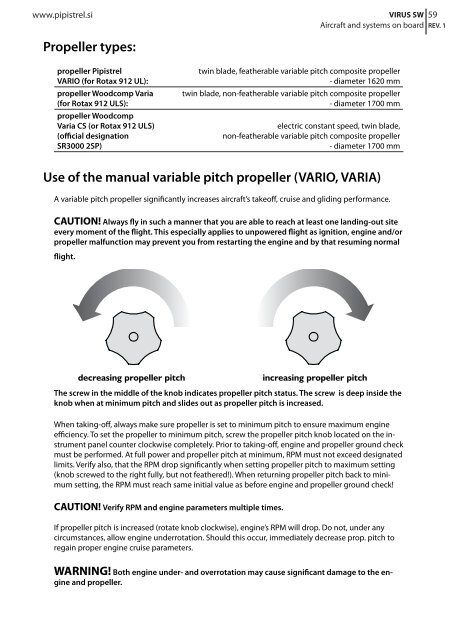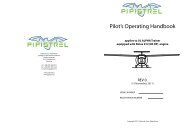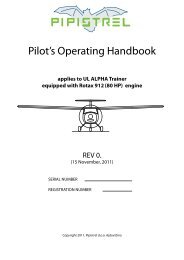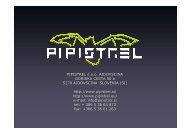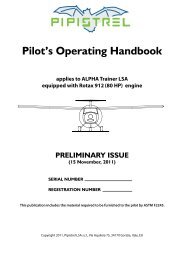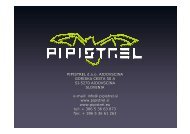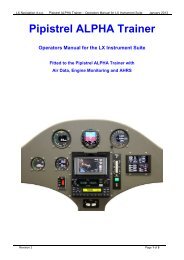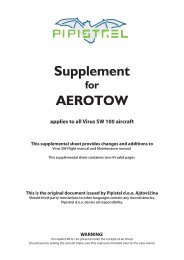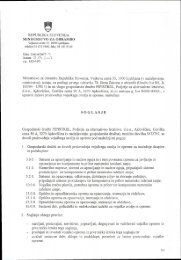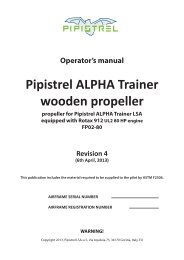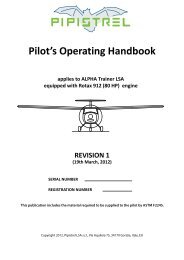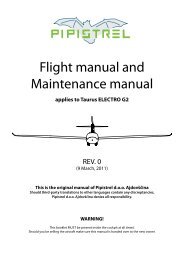Introduction - Pipistrel
Introduction - Pipistrel
Introduction - Pipistrel
You also want an ePaper? Increase the reach of your titles
YUMPU automatically turns print PDFs into web optimized ePapers that Google loves.
www.pipistrel.si<br />
VIRUS SW 59<br />
Aircraft and systems on board<br />
REV. 1<br />
Propeller types:<br />
propeller <strong>Pipistrel</strong><br />
VARIO (for Rotax 912 UL):<br />
propeller Woodcomp Varia<br />
(for Rotax 912 ULS):<br />
propeller Woodcomp<br />
Varia CS (or Rotax 912 ULS)<br />
(official designation<br />
SR3000 2SP)<br />
twin blade, featherable variable pitch composite propeller<br />
- diameter 1620 mm<br />
twin blade, non-featherable variable pitch composite propeller<br />
- diameter 1700 mm<br />
electric constant speed, twin blade,<br />
non-featherable variable pitch composite propeller<br />
- diameter 1700 mm<br />
Use of the manual variable pitch propeller (VARIO, VARIA)<br />
A variable pitch propeller significantly increases aircraft’s takeoff, cruise and gliding performance.<br />
CAUTION! Always fly in such a manner that you are able to reach at least one landing-out site<br />
every moment of the flight. This especially applies to unpowered flight as ignition, engine and/or<br />
propeller malfunction may prevent you from restarting the engine and by that resuming normal<br />
flight.<br />
decreasing propeller pitch<br />
increasing propeller pitch<br />
The screw in the middle of the knob indicates propeller pitch status. The screw is deep inside the<br />
knob when at minimum pitch and slides out as propeller pitch is increased.<br />
When taking-off, always make sure propeller is set to minimum pitch to ensure maximum engine<br />
efficiency. To set the propeller to minimum pitch, screw the propeller pitch knob located on the instrument<br />
panel counter clockwise completely. Prior to taking-off, engine and propeller ground check<br />
must be performed. At full power and propeller pitch at minimum, RPM must not exceed designated<br />
limits. Verify also, that the RPM drop significantly when setting propeller pitch to maximum setting<br />
(knob screwed to the right fully, but not feathered!). When returning propeller pitch back to minimum<br />
setting, the RPM must reach same initial value as before engine and propeller ground check!<br />
CAUTION! Verify RPM and engine parameters multiple times.<br />
If propeller pitch is increased (rotate knob clockwise), engine’s RPM will drop. Do not, under any<br />
circumstances, allow engine underrotation. Should this occur, immediately decrease prop. pitch to<br />
regain proper engine cruise parameters.<br />
WARNING! Both engine under- and overrotation may cause significant damage to the engine<br />
and propeller.


